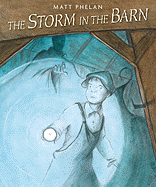Everyone in education has heard about different learning styles; some of the most prominent are visual, auditory, and kinesthetic. Perhaps educators have even considered their own learning style and how it influences teaching. But, has consideration ever been given to how these learning styles impact inspiration, interest, and research for a project that follows the inquiry process?

Take, for example, book creators Karen Hesse and Matt Phelan. Karen is the Newbery Award-winning author of Out of the Dust (Scholastic 1997). Matt has illustrated numerous books (including Susan Patron’s Newbery Award-winning The Higher Power of Lucky) and has recently completed a graphic novel entitled The Storm in the Barn (Candlewick 2009). Each of these authors have researched and created books about living in the Dust Bowl during the 1930’s.

Since Karen is an author, it could be assumed that her inquiry style would be motivated by language and words. Since Matt is an illustrator, perhaps his inquiry style would be motivated by images and pictures. Read their own words below and then ask students if they agree about the assumptions related to the inquiry process used by each author.
 Karen Hesse on Out of the Dust
Karen Hesse on Out of the Dust
Fourteen years ago when this project [of writing Out of the Dust] began, I didn’t set out to write a novel about the Dirty Thirties and the Great Depression. In fact, I was working on a picture book about a little girl named Tess living in an urban setting during a miserably hot, dry summer. The catch phrase in the picture book was, “come on rain.”
When I read that manuscript to my writer’s group, [fellow writer] Eileen Christelow—who can be a fairly demanding critic—asked, “Why does the little girl want rain so much?” That question started me thinking about times throughout history when people really wanted rain, and before I knew it I’d put the picture book aside and found myself elbow deep in research about Oklahoma dust. Because of Eileen’s question that day, two books emerged: the picture book Come on Rain and the novel Out of the Dust.
Listen to Karen Hesse introduce and read from Out of the Dust.
 Matt Phelan on The Storm in the Barn
Matt Phelan on The Storm in the Barn
(Text reprinted with permission from Candlewick Press, pages 202-203.)
As a kid, I poured over my dad’s oversized hardback volumes of Works Progress Administration (WPA) photography. The stark black-and-white images…grabbed my attention. It was the faces. Against a backdrop of a vanishing farmland, these faces stared at the camera with haunting directness.
Ten years ago, I watched…actual film footage—not just still photos—of massive dust clouds covering whole towns, people scrambling for cover… I began to imagine what the experience of living in the Dust Bowl must have been like through the eyes of a kid… The rain had gone away. But where?
Each time [I went back to those photos during the making of this book], I tried to absorb some small feeling for that strange era, so that I could tell this Dust Bowl story with pictures of my own.
Five years ago, for reasons I can’t explain, I sketched a tall, dark, sinister figure with a face like a thunderstorm.
Listen to Matt Phelan introduce The Storm in the Barn.
Based on the above insights from Hesse and Phelan, their words demonstrate that inquiry is driven by personal experience, perspective, and learning style. It can also be driven by questions posed by others. It is a good reminder that even when the research topic is the same, two different people will approach it in entirely different ways. And both of them can be incredibly successful with their outcomes.
Questions for encouraging students to explore their own inquiry process:
- What inspires you? Poetry? Art? Dance?
- How do you research a topic? Do you look for words? Pictures?
- What medium do you use to present your findings? A story? Essay? Illustration? Graphic novel?
- How might it be helpful to discuss your research with others?
This post was originally published as an article in Carin Bringelson and Nick Glass’ monthly column for School Library Monthly.

Leave a Reply